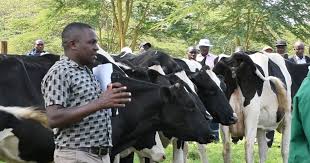The national government will support local farmers to grow yellow maize as it pushes to realize food security and curb the rising cost of animal feeds.
Principal Secretary, State Department for Livestock, Ministry of Agriculture, Livestock, Fisheries and Irrigation, Mr. Harry Kimtai said the government was working on a policy framework that would allow industrialists to contract Kenyan farmers to grow the crop and help reduce overreliance on imports.
He said the produce would mostly be used to supply the animal feed sector “though yellow maize is billed to be more nutritious than white maize as a human diet”.
Kimtai stated that the high cost of imported yellow maize, a key raw material in animal feed manufacture, occasioned by the current shortage has seen processors operate at 40 percent of their installed capacity while many more have had to close.
The Principal Secretary added, “The price of animal feeds has shot up to historic levels. A long term measure to curb the rising cost is to put in place a framework that will encourage processors contract local farmers to supply the raw material.”
The Kenya Agricultural and Livestock Research Organization (KALRO) has developed a drought-resistant variety of the yellow maize seed for distribution to farmers.
Kimtai who was flanked by Kenya Agricultural Livestock Research Organization (KALRO) Director General Dr. Eliud Kireger spoke at a Nakuru hotel during a consultative forum for Agricultural Officers from North Rift counties.
The meeting convened by Grassland and Rangeland Society of Kenya (GRASK) was also attended by representatives from research and educational institutions, agricultural experts and small holder and large scale livestock farmers from the six counties.
The Principal Secretary further noted that locally grown yellow maize could also be used by millers to blend flour meant for human consumption.
Kenyans have for a long time frowned upon yellow maize considering that it is mostly imported as famine relief food and its use as livestock feed in countries of origin.
Kimtai said yellow maize contains higher levels of lutein, carotenoids and vitamin A whose deficiency among children in Africa may result in illness, blindness and even death.
He indicated that the government had exempted duty on imported raw materials used to manufacture animal and chicken feed and developed a policy in consultation with animal feed processors to import yellow maize that is 99.1 per cent non-GMO. In an earlier notice the Government had indicated that it would only allow 100 per cent non-GMO yellow maize into the country.
Other than yellow maize, other materials that have been exempted from import duty include soya bean meal, soya bean, cotton seed cake, sunflower seed cake, white sorghum, fish meal, dried distillers grains with solubles and Rapeseed cake.
However, even after the government had offered the duty waiver, importers were still unable to import raw materials given Kenya’s ban on GMO products, according to the Association of Kenya Feeds Manufacturers (Akefema).
According to the association’s secretary-general Martin Kinoti, European countries that would have supplied the materials do not meet Kenya’s demands for 100 per cent GMO-free.
“It is not possible to get 100 percent GMO-free animal feed anywhere and if you do, it is for specialty feed, which is twice the price,” noted Kinoti.
Kinoti lamented that the high cost of feeds has made it difficult for their products to move in the market as farmers cut down on the quantities that they would buy previously, because of the price factor, which is beyond their reach.
Treasury has climbed down from 100 per cent GMO-free to 99.1 per cent, not only for imported yellow maize but also for soya bean, soya bean meal, sunflower cake and white sorghum.
The Gazette notice also extends the window for imports by another six months. The list of millers allowed to import duty-free animal and chicken feeds has also been increased from 18 to 26 millers. The yellow maize shall have a moisten content not exceeding 13.5 per cent as provided for under the laws of Kenya and Kenyan standards.
Its aflatoxin levels shall not exceed ten parts per billion as provided for under the laws of Kenya and Kenyan Standards (KSEAS2:2017) implemented by the Kenya Bureau of Standards (KEBS) and the Department of Veterinary Services which is under the State Department of Livestock. Aflatoxin is a toxin produced by fungi due to exposure to moisture.
By Jane Ngugi and Dennis Rasto





